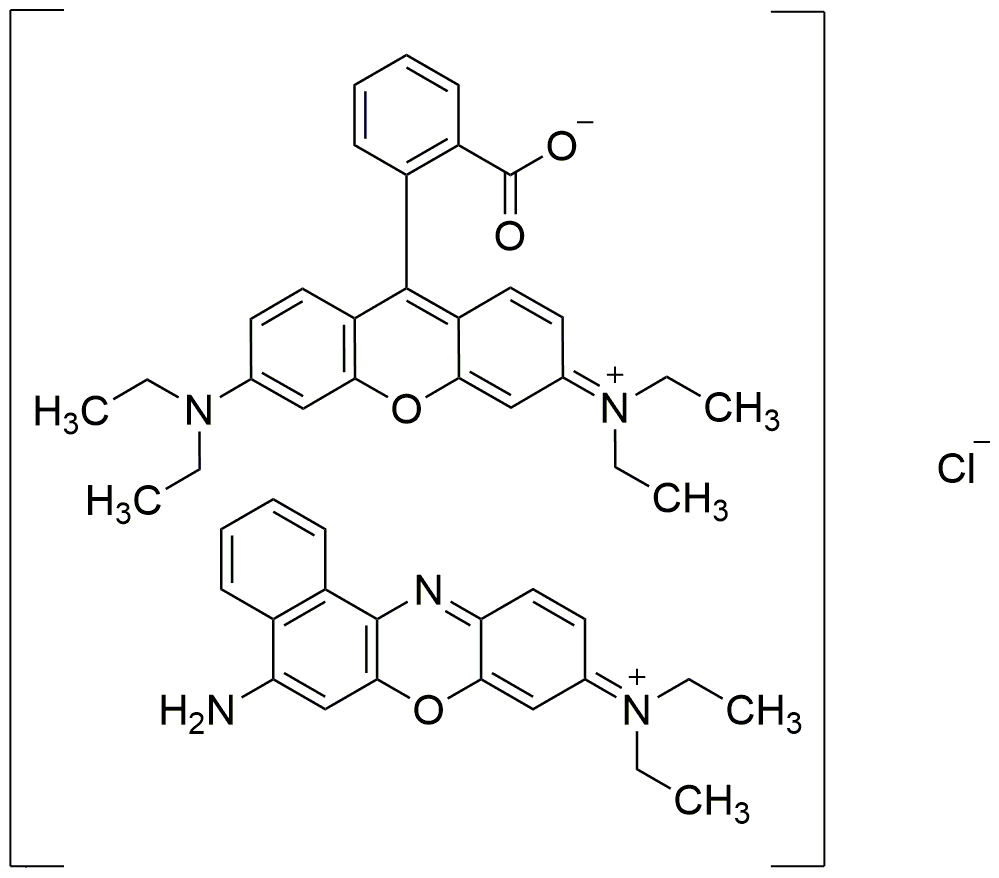Rhodanile Blue is widely utilized in research focused on:
- Biological Staining: This compound serves as a vital dye in histology and cytology, allowing researchers to visualize cellular structures under a microscope. Its ability to bind to specific cellular components enhances the clarity of tissue samples.
- Fluorescent Probes: In biochemical assays, Rhodanile Blue is employed as a fluorescent probe, aiding in the detection of various biomolecules. This application is particularly beneficial in drug discovery and molecular biology studies.
- Environmental Monitoring: The compound is used in assessing water quality by detecting heavy metals and pollutants. Its sensitivity to environmental changes makes it a valuable tool for researchers in environmental science.
- Textile Industry: Rhodanile Blue finds application as a dye in textiles, providing vibrant colors while being more environmentally friendly compared to traditional synthetic dyes. This is advantageous for manufacturers aiming for sustainable practices.
- Photodynamic Therapy: In medical research, Rhodanile Blue is explored for its potential in photodynamic therapy, a treatment that uses light-activated compounds to target and destroy cancer cells, offering a promising alternative to conventional therapies.
General Information
Properties
Safety and Regulations
Applications
Rhodanile Blue is widely utilized in research focused on:
- Biological Staining: This compound serves as a vital dye in histology and cytology, allowing researchers to visualize cellular structures under a microscope. Its ability to bind to specific cellular components enhances the clarity of tissue samples.
- Fluorescent Probes: In biochemical assays, Rhodanile Blue is employed as a fluorescent probe, aiding in the detection of various biomolecules. This application is particularly beneficial in drug discovery and molecular biology studies.
- Environmental Monitoring: The compound is used in assessing water quality by detecting heavy metals and pollutants. Its sensitivity to environmental changes makes it a valuable tool for researchers in environmental science.
- Textile Industry: Rhodanile Blue finds application as a dye in textiles, providing vibrant colors while being more environmentally friendly compared to traditional synthetic dyes. This is advantageous for manufacturers aiming for sustainable practices.
- Photodynamic Therapy: In medical research, Rhodanile Blue is explored for its potential in photodynamic therapy, a treatment that uses light-activated compounds to target and destroy cancer cells, offering a promising alternative to conventional therapies.
Documents
Safety Data Sheets (SDS)
The SDS provides comprehensive safety information on handling, storage, and disposal of the product.
Product Specification (PS)
The PS provides a comprehensive breakdown of the product’s properties, including chemical composition, physical state, purity, and storage requirements. It also details acceptable quality ranges and the product's intended applications.
Certificates of Analysis (COA)
Search for Certificates of Analysis (COA) by entering the products Lot Number. Lot and Batch Numbers can be found on a product’s label following the words ‘Lot’ or ‘Batch’.
*Catalog Number
*Lot Number
Certificates Of Origin (COO)
This COO confirms the country where the product was manufactured, and also details the materials and components used in it and whether it is derived from natural, synthetic, or other specific sources. This certificate may be required for customs, trade, and regulatory compliance.
*Catalog Number
*Lot Number
Safety Data Sheets (SDS)
The SDS provides comprehensive safety information on handling, storage, and disposal of the product.
DownloadProduct Specification (PS)
The PS provides a comprehensive breakdown of the product’s properties, including chemical composition, physical state, purity, and storage requirements. It also details acceptable quality ranges and the product's intended applications.
DownloadCertificates of Analysis (COA)
Search for Certificates of Analysis (COA) by entering the products Lot Number. Lot and Batch Numbers can be found on a product’s label following the words ‘Lot’ or ‘Batch’.
*Catalog Number
*Lot Number
Certificates Of Origin (COO)
This COO confirms the country where the product was manufactured, and also details the materials and components used in it and whether it is derived from natural, synthetic, or other specific sources. This certificate may be required for customs, trade, and regulatory compliance.


